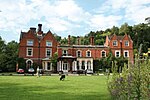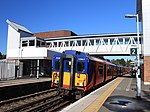Box Hill & Westhumble railway station
Box Hill, SurreyCharles Henry Driver railway stationsChâteauesque architectureFormer London, Brighton and South Coast Railway stationsGrade II listed railway stations ... and 5 more
Railway stations in Great Britain opened in 1867Railway stations in SurreyRailway stations served by Govia Thameslink RailwayRailway stations served by South Western RailwayUse British English from October 2012

Box Hill & Westhumble is a railway station in the village of Westhumble in Surrey, England, approximately 2 miles (3.2 km) north of Dorking town centre. Box Hill is located approximately 1⁄2 mile (800 m) to the east. It is 21 miles 14 chains (34.1 km) down the line from London Waterloo. Train services are operated by Southern who manage the station, and South Western Railway.The station is the end point for the Thames Down Link long-distance footpath from Kingston upon Thames, and lies close to the midpoint of the Mole Gap Trail between Leatherhead and Dorking. The station is within 1⁄2 mile (800 m) of the North Downs Way.
Excerpt from the Wikipedia article Box Hill & Westhumble railway station (License: CC BY-SA 3.0, Authors, Images).Box Hill & Westhumble railway station
Westhumble Street, Mole Valley
Geographical coordinates (GPS) Address Nearby Places Show on map
Geographical coordinates (GPS)
| Latitude | Longitude |
|---|---|
| N 51.254 ° | E -0.329 ° |
Address
Westhumble Street
RH5 6AF Mole Valley
England, United Kingdom
Open on Google Maps










